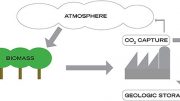Carbon capture and sequestration (CCS) is a fledgling technology still mostly relegated to demonstration projects in the U.S. and other parts of the globe. While not yet commercialized, its prospects of putting coal-fired plants on the same footing with natural gas facilities – from a carbon dioxide (CO2) emissions perspective – gives it an innovative allure. CCS was one of several topics covered at the Greenhouse Gas Strategic Forum held in Kansas City, Mo. The two-day event, sponsored by Black & Veatch, attracted nearly 100 utility executives, industry leaders and government regulatory personnel. The forum was designed to address issues surrounding the U.S. Environmental Protection Agency’s (EPA) proposed Clean Power Plan.
The plan has set a target of reducing CO2 emissions from existing coal-fired plants by 30 percent by 2030. CCS has the capability to address some of the issues outlined in the Clean Power Plan, and could be considered for new generation, said Tom Guenther, CCS Technology Manager for Black & Veatch.
“In order to achieve the same CO2 emissions as a natural gas plant, CCS must capture approximately 60 percent of the CO2 from a typical coal-fired plant,” Guenther said. “It takes a lot of equipment and a lot of energy to capture CO2.”
While CO2 has limited industrial uses, there are only two primary methods for keeping it out of the atmosphere. “You have to get it into the ground permanently, and the two methods of doing that today are enhanced oil recovery (EOR) and sequestration,” Guenther told the gathering. “For EOR, we pressurize and liquefy the CO2, pump it into the geologic formations where the oil is trapped, and then force out the oil. Most of the CO2 remains trapped in the formations, theoretically, forever.”
He said for sequestration, the process is to pressurize the CO2 and put it deep into the ground in order to keep it out of the atmosphere.
Energy Penalty
Guenther said there are three techniques for capturing carbon dioxide: 1) post-combustion, in which CO2 is captured after firing; 2) pre-combustion, which is associated with integrated gasification combined cycle (IGCC) technology; and 3) oxy-fuel combustion, in which pure oxygen, rather than air, is used in the combustion process.
Post-combustion CCS causes power plants to lose electrical output through two means. The process uses electricity to power fans, pumps, compressors and other equipment. In addition, it takes a substantial amount of steam off the turbine, which also results in a loss of power produced. The combined usage of steam and electricity is called the energy penalty, Guenther said. It can cause a 25 to 30 percent overall loss of output for post-combustion capture.
The large energy penalty is one of the reasons CCS hasn’t been widely adopted commercially. He said a small 25 megawatt demonstration coal plant was built in Alabama with post-combustion technology, and it worked quite well. But the plant has since been decommissioned, since it accomplished its testing purpose and there was no long-term commercial usage for it.
A medium-sized coal-fired plant in Canada is preparing to implement CCS. It will be rated at 110 MW after CCS, but would likely have had an output of about 150 MW before CCS. There is also a large CCS plant being built near Houston that is expected to be online in 2016 that will feature 90 percent carbon capture from a 240 MW coal flue gas slip-stream, Guenther said. The captured carbon from both facilities will be used for EOR, and in fact, will provide revenue streams to its owners to help offset some of the cost of CCS.
IGCC and Oxy-Fuel
A large 582-MW IGCC unit is being built in Mississippi, with 65 percent carbon capture, that is expected to be completed in 2015. A 60-mile pipeline is being constructed to move the CO2 for onshore EOR, Guenther said.
Guenther said oxy-fuel combustion is the least-developed of the three technologies. However, a demonstration plant is scheduled to begin construction soon in Illinois, with completion set for 2017. It would feature 90 percent carbon capture, along with a 30-mile pipeline for sequestration.
One major drawback to oxy-fuel combustion technology is the amount of equipment and energy required to produce pure oxygen, which requires separating it from air. In addition, a portion of the CO2-rich flue gas must be recirculated to dilute the oxygen in order to control furnace temperature, requiring additional equipment and energy consumption, Guenther said.
Another major drawback to CCS, besides the cost, is the large footprint required at a power plant site for the additional equipment. For example, the components needed for post-combustion capture add about 50 percent to the footprint of a typical coal-fired power plant, he said.
“Through various demonstration projects, carbon capture has been shown to be a technically viable solution. But at the same time, unless it becomes mandated or subsidized, it is not economical,” Guenther said. “At this time, it would appear that enhanced oil recovery is the best pathway for commercial operation.”
Gordon Heft, Black & Veatch
Originally published in Bv.com website







Be the first to comment on "Carbon Capture and Sequestration Still in Fledgling Stage as Commercial Adoption Is Slow"